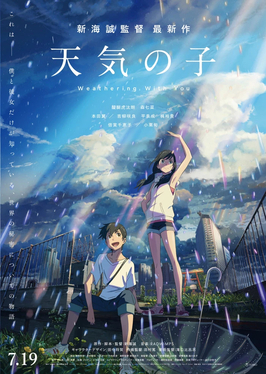A Beautiful Animated Spectacle and a Lesson in Climate Change: Weathering With You

Notes: I can’t review Knives Out or Cats, as they are leaving theaters. For a more humorous review of the latter, check out Anjali’s Trash Talk article from last month. I can also review both once they hit streaming services, if interest is still there. I can’t review Parasite either because of the age restriction and my parents’ advice. I may write something about the Oscars for a later month, but I could only see a fraction of the films. Time will tell.
Also, I got some in-person requests for movies. I appreciate it, but from now on please leave them in the Tatler poll. Thanks!
On the Saturday of MLK Day weekend, I went to see Weathering With You. I heard that it was made by the creator of Your Name, a phenomenal movie, but I otherwise went in with low expectations. I… wasn’t exactly blown away, but I came away thinking the movie was pretty good. The movie isn’t a masterpiece like Your Name, but it does touch on something relevant to our time: the relationship between youth and climate change.
Weathering With You is directed by director Makoto Shinkai, director of the legendary Your Name. Weathering With You is the story of two teenagers, Hodaka and Hina. Hodaka is a runaway trying to find a job and place to stay in Tokyo amidst a record-breaking rainstorm. His quickly overwhelmed wonder is displayed just as his character is introduced: he nearly drowns from falling off a boat. He eventually finds a job as the assistant to a tabloid writer, Keisuke Suga, and Suga’s niece Natsumi. By fate, he meets Hina, a girl who secretly lives and provides for her and her younger brother, Nagi. He discovers that she is a Weather Maiden (or “Sunshine Girl” as a common term), able to, with a prayer, clear the ever-present rain to reveal the sun, if only temporarily. They decide to start up a business of clearing up skies on events like weddings, festivals, and baseball games. As we learn later, though, there is a sacrifice that comes with being a Weather Maiden.
I saw the English dub of Weathering With You. I generally avoid English dubbed versions of Japanese media, with a few notable exceptions (such as Mark Hamill as Muska in Castle in the Sky). This is mostly because the children’s voice actors tend to not match up with the quirks of Japanese language. Despite this, Weathering With You’s voice acting was surprisingly solid. The characters gave good, natural impressions of their characters that accurately portrayed what was happening to and around them (Hodaka’s voice admittedly got a bit annoying after some time, but he is a high school freshman, so really, what can I say?). Their voices all had fervor yet also subtlety–something lacking even in some Ghibli films. The blending of the dubbed-over English voices and original sound effects were also incredibly smooth, which is difficult for even Japanese-dubbed anime.
Aside from acting, the technical achievements in this movie are just astounding. I really got the sense of gloom around Tokyo as the rain stretches from hours to days to months (*insert Seattle joke here*). Every scene has tiny, meticulous details (light refracting on windows, water beads, translucent plastic coating, “Since 1987” on a beer can) that provide an ambiance and texture that exceeds even that of some Ghibli films. The more you examine even a single frame, the more impressive it gets: the water fish, the clouds, panning shots of Hodaka and Hina on a rooftop, individual raindrops falling through the air. The whole movie is a masterwork in animation. You could watch the movie on mute and know exactly what was happening.
The main problem I have with this movie is the ending.
*Spoilers ahead. Read with discretion*
Hina learns that although she can return the weather back to normal, she will have to sacrifice herself as the weather maiden to do so. Eventually Hodaka finds a way to bring her back. Hina warns that doing this will bring back the incessant rain, but he claims to not care and that they should just be together.
The choice they make impacts the entirety of Tokyo, perhaps the whole world, condemning thousands to the sea. People lose their homes, livelihoods, perhaps themselves. Hodaka and Hina are happy, but at what cost? This ending bugged me for a long time after the credits rolled, especially since the implications of this bold new world are never really explained.
Perhaps backed by Greta Thunberg’s speech to the UN, an idea touched upon in this movie is that the next generation, ours, will have to figure out how to save ourselves. In the movie, only Hodaka and Hina know the truth. Everyone in power refuses to believe the scope of the problem. In addition, Hina must sacrifice herself to save this crisis. This implies something that Thunberg and many others are saying: we, the next generation, as the inheritors of the earth, must figure out a way to save it. This may cause us to lose ourselves, but compared to the loss everybody else sharing the Earth would face, the sacrifice seems tiny. Like the life of one high school girl in a hotel in Tokyo.
In that context, we must think about Hodaka’s decision. Would we really want to sacrifice our only treasure in the world to clean up a debacle our elders left for us? Given the same situation, what would we do? Our elders do not seem to know, nor do they very much care.
We’ll have to figure that out.
You can take the woman out of the bird, but you can't take the bird out of the woman: meet Yoon Lee.
